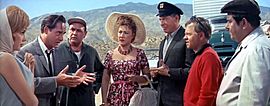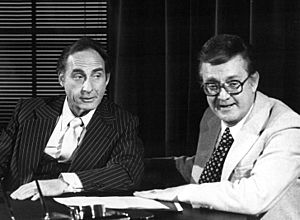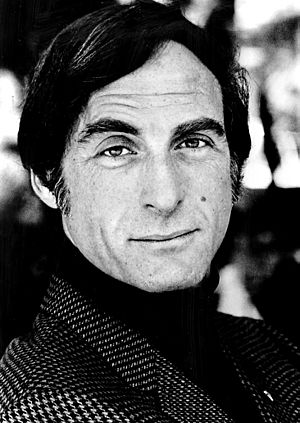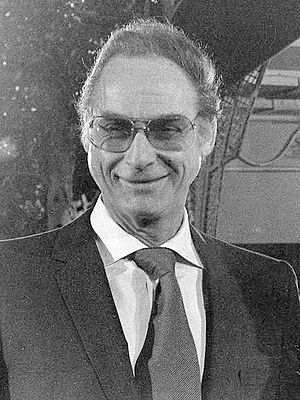Sid Caesar facts for kids
Quick facts for kids
Sid Caesar
|
|
|---|---|

Caesar in 1961
|
|
| Born |
Isaac Sidney Caesar
September 8, 1922 Yonkers, New York, U.S.
|
| Died | February 12, 2014 (aged 91) |
| Occupation |
|
| Years active | 1945–2005 |
| Height | 6 ft 1+1⁄2 in (187 cm) |
| Spouse(s) |
Florence Levy
(m. 1943; died 2010) |
| Children | 3 |
Isaac Sidney Caesar (born September 8, 1922 – died February 12, 2014) was a very famous American comedian, actor, and writer. He had a career that lasted 60 years!
Sid Caesar was best known for his groundbreaking TV shows in the 1950s: Your Show of Shows (1950–1954) and Caesar's Hour (1954–1957). These live shows were watched by millions and inspired many future comedians. His shows even won Emmy awards.
Unlike stand-up comedians, Caesar was a "sketch comic." He used his body, different accents, and funny faces more than just words to make people laugh. His comedy was seen as very new and different for its time. Many famous writers like Mel Brooks, Neil Simon, and Woody Allen started their careers writing for him.
Sid Caesar also acted in movies, including playing Coach Calhoun in Grease (1978) and Grease 2 (1982). He was nominated for 11 Emmy Awards and won twice. He was also a talented saxophonist and wrote several books. People called him "television's Charlie Chaplin" because of his amazing physical comedy.
Contents
Early Life and Learning Comedy
Sidney Caesar was the youngest of three sons in a Jewish family. He was born in Yonkers, New York. His parents, Max and Ida Caesar, ran a busy 24-hour restaurant.
Working at the restaurant helped young Sid learn to copy how different customers spoke. He would listen to their accents and rhythms. He called this skill double-talk. He could pretend to speak many languages using made-up sounds that sounded real. He would try this with customers from Italy, Poland, Russia, and more, and they loved it!
Sid's older brother, David, was a big supporter and helped him create early comedy sketches. They would act out scenes from movies like Test Pilot. When he was 14, Sid played the saxophone in a band in the Catskill Mountains. He also started performing comedy sketches there.
Starting His Career
From Music to Comedy Star
After finishing high school in 1940, Sid Caesar wanted to be a musician. He moved to Manhattan and worked at the Capitol Theater. He played saxophone at a resort in the Catskill Mountains and learned more about comedy. He even took classes for clarinet and saxophone at the Juilliard School of Music.
In 1940, he joined the United States Coast Guard. He performed in military shows and revues. While in the Coast Guard, he met Max Liebman, who later produced Sid's first TV series. Caesar's comedy acts in these shows were so popular that people applauded more for them than for the music!
After leaving the military in 1945, Sid Caesar moved to Hollywood. He acted in a movie version of one of his military shows, Tars and Spars. He also appeared in another film, The Guilt of Janet Ames. He decided not to take roles that would make him just an impersonator or a sidekick.
He soon returned to New York and started performing at the famous Copacabana nightclub. This led to a big contract and a national tour. He also performed in a Broadway show called Make Mine Manhattan, where he showed off his skills in singing, acting, double-talk, and pantomime. He even wrote some of the music! He won an award for his work in this musical in 1948.
Television Success
Becoming a TV Legend
Sid Caesar's TV career began in 1948 on Milton Berle's show. In 1949, he got his first TV series, Admiral Broadway Revue, with Imogene Coca. This show was a huge hit, but it was canceled after only 26 weeks because the sponsor couldn't make enough TVs to meet the demand!

On February 25, 1950, Your Show of Shows began. It was a 90-minute live show that mixed sketch comedy, funny spoofs of movies and TV, Caesar's monologues, and musical guests. Famous stars like Jackie Cooper and Charlton Heston appeared on the show. It also brought together a fantastic comedy team: Caesar, Coca, Carl Reiner, and Howard Morris.
Many talented writers, including Lucille Kallen, Mel Brooks, and Neil Simon, got their start writing for Your Show of Shows. Sid Caesar won his first Emmy award in 1952. The show was incredibly popular and ended in 1954 after almost 160 episodes.
A few months later, Caesar returned with Caesar's Hour. This was a one-hour sketch show with many of his old cast members. Nanette Fabray joined the cast, replacing Imogene Coca. Sid Caesar had full creative control over this live show, which had a huge budget.
After Caesar's Hour, he had a shorter show called Sid Caesar Invites You in 1958. This show briefly brought back Caesar, Coca, and Reiner, with Neil Simon and Mel Brooks writing for them.

In 1963, Sid Caesar was very busy, appearing on TV, stage, and in movies. He starred in the Broadway musical Little Me, playing eight different characters and changing costumes 32 times! He was nominated for a Tony Award for this role. He also appeared in the hit comedy movie It's a Mad, Mad, Mad, Mad World (1963).
Sid Caesar's Unique Comedy Style
Sid Caesar was known as a "sketch comic" and actor, not a stand-up comedian. He was amazing at pantomime (acting without words), using different accents, and making funny faces. He could also do "double-talk," which sounded like real languages but was mostly made-up sounds.
His sketches were often long, sometimes 10 or 15 minutes. He used a lot of close-ups to show the funny expressions on his face and the faces of other actors. His style was very different from the usual "slapstick" comedy on TV at the time. Comedian Steve Allen said Caesar was born with the ability to "write physical poetry," like a silent film comedian. For example, he and Nanette Fabray once acted out an argument using only body movements, set to Beethoven's Fifth Symphony.
Writers said that Sid didn't like one-line jokes because he felt anyone could do them. He preferred comedy that came from the characters and situations. Nanette Fabray remembered that Sid always stayed in character during live performances, unlike other comedians.
Caesar could pantomime many things, like a tire, a gumball machine, a lion, a dog, a telephone, or even a train! Alfred Hitchcock compared him to Charlie Chaplin because of his incredible physical comedy.
His double-talk routines were legendary. Carl Reiner said his ability to double-talk in every language was perfect. Sid could pretend to speak four different languages in one performance with almost no real words. Even though he sounded fluent, he only spoke English and Yiddish. He once told a reporter that every language has its own music, and if you listen, you can learn its rhythm.
What His Shows Were About
Sid Caesar's shows often made fun of real-life events and people. They also parodied popular movies, theater, TV shows, and even opera. The jokes and dialogue on his shows were considered smarter and funnier than other comedy shows of the time.
Some famous sketches included "From Here to Obscurity" (a parody of From Here to Eternity) and "Aggravation Boulevard" (making fun of Sunset Boulevard). These sketches often helped make the original movies even more popular!
He also had recurring sketches. "The Hickenloopers" was the first TV sketch about a bickering couple. Another popular one was "The Professor," where Caesar played a silly expert who pretended to know everything. This character later inspired Mel Brooks' "The Two Thousand Year Old Man." "The Commuters" sketch showed Caesar, Reiner, and Morris dealing with everyday life in the suburbs.
Working with Amazing Writers
Many comedians wanted to write for Sid Caesar's show because it was considered the best place to be. While Sid didn't write the exact words, he made all the final decisions. His writers felt they had a great "instrument" in Caesar that they could play very well. Sid was an "idea man" who let his writers take more risks than other TV shows.
Woody Allen remembered that they wrote "situations" instead of just jokes. Sometimes, the dialogue wasn't even written down; they would just describe the scene, like "Sid does man coming home from business mad." It was often "organized chaos" in the writers' room, with everyone throwing out ideas.
Neil Simon said that after the writers gave a sketch to Caesar, "Sid would make it ten times funnier than what we wrote." Simon also felt that working for Caesar was like seeing a "new country" because Caesar was doing "life" in his comedy, not just silly characters.
Impact on Television
Many people believe that Sid Caesar's shows were the very best of 1950s television. They were full of smart humor and their sketches were sharper and more advanced than other variety shows. Historians say Caesar was one of the most intelligent and creative people in TV comedy.
Actress Nanette Fabray said he was the first truly original TV comedy creation. His early shows set the "gold standard" for TV sketch comedy. In 1951, Newsweek magazine called Caesar "the best that TV has to offer."
However, his success also had an interesting effect on Broadway. People loved Caesar's show so much that they stayed home on Saturday nights to watch it instead of going to live plays. Broadway producers even asked NBC to move the show to a different night! Comedy star Carol Burnett once gave away tickets to a Broadway show because she wanted to watch Sid Caesar live on TV, knowing she might never see that again.
Later Years and Legacy
After nearly 10 years as a huge TV star, Sid Caesar's fame faded quickly. He almost disappeared from the spotlight for a while. Some people felt that the intense demands of live television had worn him out.
Throughout the 1970s and 1980s, Caesar continued to appear on TV, stage, and in movies. He reunited with Mel Brooks in films like Silent Movie and History of the World, Part I. He also played Coach Calhoun again in Grease 2 in 1982. In 1971, he starred in a Broadway show called Four on a Garden.
In 1973, Caesar and Imogene Coca reunited for a play called The Prisoner of Second Avenue. That same year, Caesar and Max Liebman put together a movie called Ten From Your Show of Shows, which was a collection of some of their best sketches from his old TV shows.

In 1983, Sid Caesar hosted an episode of Saturday Night Live, where he received a standing ovation. He was even given a plaque making him an honorary cast member! He continued to appear in movies and TV shows, including Vegas Vacation in 1997.
In 1996, the Writers Guild of America, West brought Caesar together with nine of his writers from Your Show of Shows for a special discussion. This event was filmed and later released as a DVD called Caesar's Writers.
In 2003, he celebrated the 40th anniversary of It's a Mad, Mad, Mad, Mad World. In 2004, his second autobiography, Caesar's Hours, was published. In 2006, Billy Crystal gave Caesar the Pioneer Award at the TV Land Awards. Sid Caesar gave a funny, heartfelt speech, performing his famous double-talk for over five minutes!
Sid Caesar was married to Florence Levy for 67 years until she passed away in 2010. He was proud of his Jewish heritage and believed that Jewish people have a great sense of humor because they've had to use it to get through tough times.
Death and Tributes
Sid Caesar passed away on February 12, 2014, at his home in Beverly Hills, California. He was 91 years old.
Many famous comedians shared their thoughts after his death. Carl Reiner called him "the very best sketch artist and comedian that ever existed." Mel Brooks said, "Sid Caesar was a giant, maybe the best comedian who ever practiced the trade." Woody Allen stated, "He was one of the truly great comedians of my time."
Sid Caesar was buried at Mount Sinai Memorial Park Cemetery. He was survived by his three children and two grandsons.
Filmography
Film Roles
| Year | Title | Role | Notes |
|---|---|---|---|
| 1946 | Tars and Spars | Chuck Enders | |
| 1947 | The Guilt of Janet Ames | Sammy Weaver | |
| 1963 | It's a Mad, Mad, Mad, Mad World | Melville Crump | |
| 1966 | The Mouse That Roared | Duchess / Mountjoy / Tully | Television film |
| 1967 | The Busy Body | George Norton | |
| A Guide for the Married Man | Man at Romanoff's | ||
| The Spirit Is Willing | Ben Powell | ||
| 1973 | Ten from Your Show of Shows | Unknown | Also writer |
| 1974 | Airport 1975 | Barney | |
| 1976 | Silent Movie | Studio Chief | |
| 1977 | Flight to Holocaust | George Beam | Television film |
| Fire Sale | Sherman | ||
| Curse of the Black Widow | Lazlo Cozart | Television film | |
| 1978 | The Cheap Detective | Ezra Dezire | |
| Grease | Coach Calhoun | ||
| Barnaby and Me | Leo Fisk | Television film | |
| 1980 | The Fiendish Plot of Dr. Fu Manchu | Joe Capone | |
| Dorothy in the Land of Oz | Wizard / Mince Pie | Voice | |
| 1981 | The Munsters' Revenge | Dr. Dustin Diablo | Television film |
| History of the World: Part I | Chief Caveman | ||
| 1982 | Grease 2 | Coach Calhoun | |
| 1984 | Over the Brooklyn Bridge | Uncle Benjamin | |
| Cannonball Run II | Fisherman No. 2 | ||
| 1985 | Love Is Never Silent | Mr. Petrakis | Television film |
| Alice in Wonderland | The Gryphon | ||
| 1986 | Stoogemania | Doctor Fixyer Mindyer | |
| Christmas Snow | Snyder | Television film | |
| 1987 | The Emperor's New Clothes | The Emperor | |
| 1988 | Freedom Fighter | Max | Television film |
| Side by Side | Louis Hammerstein | ||
| 1995 | The Great Mom Swap | Papa Tognetti | |
| 1997 | Vegas Vacation | Mr. Ellis | |
| 1998 | The Wonderful Ice Cream Suit | Sid Zellman | |
| 2000 | Globehunters | Jacob | Voice Television film |
| 2004 | Comic Book: The Movie | Old Army Buddy | (final film role) |
Television Appearances
| Year | Title | Role | Notes |
|---|---|---|---|
| 1949 | Admiral Broadway Revue | Regular Performer | 19 episodes |
| 1950–54 | Your Show of Shows | Himself (Regular Performer) | 139 episodes |
| 1954 | Producers' Showcase | Napoleon Bonaparte / Himself | Episode: "Dateline" |
| 1954–1957 | Caesar's Hour | Himself (Host) | Also composer |
| 1958 | Sid Caesar Invites You | Himself | 13 episodes |
| The All-Star Christmas Show | Television special | ||
| 1959 | Some of Manie's Friends | Television special | |
| The United States Steel Hour | Unknown | 2 episodes | |
| 1961 | General Electric Theater | Nick Lucifer | Episode: "The Devil You Say" |
| Checkmate | Johnny Wilder | Episode: "Kill the Sound" | |
| 1962 | As Caesar Sees It | Himself | Television special |
| 1963–1964 | The Sid Caesar Show | Himself (Host) | |
| 1966–1970 | The Hollywood Palace | ||
| 1965–1973 | The Dean Martin Show | Himself | 4 episodes, also composer |
| 1967 | The Sid Caesar, Imogene Coca, Carl Reiner, Howard Morris Special |
Himself (Co-host) | Television special |
| The Carol Burnett Show | Himself | Season 1, episodes 2 & 14 | |
| The Danny Thomas Hour | Gregory | Episode: "Instant Money" | |
| 1968 | That Girl | Marty Nickels | Episode: "The Drunkard" |
| 1969–1971 | Love, American Style | Bert / John Smith | 2 episodes |
| 1975 | When Things Were Rotten | Marquis de la Salle | Episode: "The French Dis-connection" |
| 1976 | Good Heavens | Herman Meltzer | Episode: "Herman Meltzer" |
| 1978 | Vega$ | The General | Episode: "Mother Mishkin" |
| 1978–1984 | The Love Boat | Bert Multon / Michael Harmon | 2 episodes |
| 1979 | Intergalactic Thanksgiving | King Goochi | Voice; television special |
| 1981 | The Misadventures of Sheriff Lobo | The Bomber | Episode: "Another Day, Another Bomb" |
| 1982 | Matt Houston | Prince Sergei Polansky | 1 episode |
| 1985 | Amazing Stories | Lou Bundles | Episode: "Mr. Magic" |
| 1986 | Sesame Street | Himself | Episode: "#18.19" |
| 1995 | Love & War | Mr. Stein | 2 episodes |
| 1997 | Life with Louie | Marty Kazoo | Voice |
| Mad About You | Uncle Harold | Episode: "Citizen Buchman" | |
| 2001 | Whose Line Is It Anyway? | Himself | Season 4 Episode 15 |
Awards and Special Honors
| Year | Award | Category | Project | Result | Ref. |
|---|---|---|---|---|---|
| 1948 | Donaldson Award | Male Debut in a Musical | N/A | Won | |
| 1951 | Primetime Emmy Award | Most Outstanding Personality | N/A | Nominated | |
| Best Actor | N/A | ||||
| Look magazine | Best Comedian on TV | N/A | Won | ||
| 1952 | Primetime Emmy Award | Best Actor | N/A | ||
| Best Comedian or Comedienne | N/A | Nominated | |||
| 1953 | Best Comedian | N/A | |||
| 1954 | Best Male Star of Regular Series | Your Show of Shows | |||
| 1956 | Best Comedian | N/A | |||
| 1956 | Look magazine | Best Comedian on TV | N/A | Won | |
| 1957 | Primetime Emmy Award | Best Actor in a Comedy Series | Caesar's Hour | ||
| 1958 | Nominated | ||||
| 1963 | Tony Award | Best Actor in a Musical | Little Me | ||
| 1987 | British Comedy Awards | Lifetime Achievement Award in Comedy | N/A | Honored | |
| 1995 | Primetime Emmy Award | Outstanding Guest Actor - Comedy Series | Love & War | Nominated | |
| 1997 | Mad About You | ||||
| 2001 | Television Critics Association | Career Achievement Award | N/A | Honored | |
| 2006 | TV Land Award | Pioneer Award | N/A | ||
| 2011 | Television Critics Association | Lifetime Achievement Award | N/A |
Other Honors
- 1960: Sid Caesar received a star on the famous Hollywood Walk of Fame.
- 1985: He was welcomed into the Television Academy Hall of Fame.
In 2005, The Humane Society of the United States created the "Sid Caesar Award for Television Comedy." This award is given to people in media who create great works that help raise awareness about animal issues. Sid Caesar was a dedicated supporter of the Humane Society.
Images for kids
-
Caesar attending Mark Twain Prize for American Humor in 2000
See also
 In Spanish: Sid Caesar para niños
In Spanish: Sid Caesar para niños




